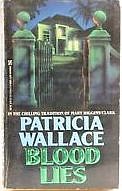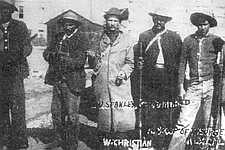 Facebook
Facebook
 X
X
 Instagram
Instagram
 TikTok
TikTok
 Youtube
Youtube


SYDNEY DROVE to the Union-Tribune building on Camino de la Reina in Mission Valley. She made a left into the only entrance and coasted to a stop at the guard gate. Her power window glided soundlessly down.
I've come to place an ad,” she said before the guard could ask, then peered at the main building, an imposing red brick structure nestled within tall ivy-covered walls. Six stories high, its smoked glass windows overlooked Highways 8 and 163. “Is this the right place?”
“Sure is. Visitor’s lot is the first section to your right.”
She nodded her thanks and drove through. Apparently there weren’t many visitors today, and she had her choice of spaces. After parking, she glanced back at the guard to see if he was watching.
He was.
Not wanting to arouse his suspicions, she got out and headed toward the curved pathway that led to the front doors. Walking slowly, she had time to wonder at Victor Griffith — ever the iconoclast and frequently outrageous — working in a staid environment like this.
As conservative as the buildings and grounds were, the lobby was even more so. Dark wood paneling and somber gray carpet brought to mind not reporters sniffing out a story but rather morticians determined not to of. fend the bereaved with even a single splash of color during the bleakest period of life At the center of the lobby sat a kiosk. This, Victor had' told her, was where one placed a classified ad. And he had helpfully supplied her with a dummy ad purporting to offer Free Kittens to Good Homes.
When she’d protested that some little kid calling for a free kitten would be heartbroken to find the ad a hoax, he’d shrugged and said, “Life is hard.”
Beyond the kiosk she could see a second guard sitting quietly but alert at a desk near the elevators. No one was allowed access to the upper floors without an appointment, and the keeper of the castle did not look as if he would be at all adverse to applying a little physical emphasis to company policy
Sydney watched him as he crossed the lobby, half expecting him to challenge her right to be there, but his hooded eyes regarded her benignly, evidently having found her beneath concern.
Patricia Wallace Blood Lies 1991
VISTA, CALIFORNIA — It was what has become a typical Thursday night school board meeting in this town of 76,000, in the rolling hillsides below Camp Pendleton, two hours south of Los Angeles. Preachers squaring off against scientists, disciples of the Lord Jesus Christ hurling passages of Ben Franklin at parents responding with Thomas Jefferson. One man, a tall, sturdy evangelist, touched his Bible and began, “Praise the Lord for this liberty to speak.”
He enunciated slowly, menacingly, like Robert Mitchum in The Night of the Hunter. “Hitler was an evolutionist.” One hundred and fifty people spread among the plush seats at the Buena Vista High School Performing Arts Center hooted, booed, or cheered — drawn out this windswept, stormy February night by the prospect that the newly constituted Christian fundamentalist majority on the Vista Unified School District Board of Trustees would take some action concerning prayer that might lead straight to the U.S. Supreme Court. One month earlier, a crowd of 500 filled another auditorium, and 200 more camped in the doorways and peered through the windows, to hear the same board debate teaching creationism in science classes. The topic ignited a meeting that typically attracts a dozen onlookers from the quiet bedroom community, nestled in the usually calm confines of North San Diego County. This time, after two hours of rancorous rhetoric — more quotes from scripture, further readings from the Constitutional Convention — the school board trustees decided to say a prayer before every meeting....
Built upon undulating hills, seven miles inland from the Pacific Ocean, the formerly citrus- and avocado-growing town has been transformed in the last several years into a model American edge city. The Shadowridge housing development, where many of the white-flighters live, sprawls atop the southern rim of the city, scarred by row after row of two-story replicant Spanish homes, so unvaried in size, shape, and color that even Steven Spielberg might find the location bland. Street signs are markers for fauna and flora — Quail and Chaparral — that have been paved over. At intervals of no more than five minutes driving time, malls punctuate the ceaseless monotony. Farther down the road, entire hillsides are scored with paved streets leading to empty pads, awaiting the next set of stuccoed and tiled domiciles. Vista, as [Christian fundamentalist school-board member] John Tyndall noted, “was recently rated one of the best communities to bring your children up in.” ...
The migration away from the social strife — and the abandonment of the social contract — has ended in the selfish demimonde of San Diego County, adjacent to the Mexican border.
Taking advantage of laissez faire Reaganism, when environmental concerns, zoning laws, and tax tables were altered to promote real estate speculation, Vista grew like topsy. Its population doubled in less than 10 years. The town went from a community of marines (from nearby Camp Pendleton), mobile home dwellers, and retirees, to a community of younger, middle-class, pull-up-the-drawbridge families. The relative tranquility of Vista was “nirvana,” as one longtime resident put it, attracting parents fretting over the collapse of the cities, and worried that deindustrialization might drag them down, too. “The first thing anybody asks you in Vista,” says one resident of four years, “is, when did you move here?”
Greg Goldin “The 15 Per Cent Solution” The Village Voice April 6, 1993

SAN DIEGO SEEMED TO BE HAVING its share of troubles. The paper Mike read made waspish reference to a Mr. Spreckels who, it seemed, might have brought fewer of these troubles on himself if he’d been willing to pay his workers a living wage. After a page or two Mike came to the abrupt realization that the IWW, the Wobblies, and the International Workers of the World were all the same organization.
He turned a page and discovered the next section of the paper was devoted to “The Situation in Tijuana.” There was no news, he concluded, for the paper had wasted a whole page on rehashing the history of the Republic of Equalia. It had, Mike discovered, originally been founded by a couple of Mexican socialists fed up with thirty years of Diaz.
With old Diaz in trouble and Jack London grinding out socialist propaganda it had seemed like a sure thing. But when the socialists, Berthold and Leyva, shouted, “Comrades arise! You’ve nothing to lose but your chains,” the bajacalifornianos gave the pair of rebels an incurious glance and went back to their mining and ranching. Life in waterless Baja was grim enough without playing politics.
But Berthold and Leyva’s insurrectos got hungry. When a ranchero near Ensenada objected to the little army’s provisioning methods his reply caused Berthold to die of lead poisoning. Leyva was ready to give up when help came unexpectedly from the gringos — a rabble of Wobblies bearing a mind-boggling assortment of shot-out guns, flags, and hot air. By the time the Wobblies had thinned out to a hundred diehards some Italians had left Sacramento to come down and liberate their Latin brothers from the iron heel of capitalism. Most of these original bands had been wiped out in battles at Mexicali and Tecate. The original Mexican rebels had become so disgusted with their American helpers that they’d pulled out and gone back to farming. Then Stanley Williams had appeared.
No one knew his real name. He was a deserted [sic] from the 9th U.S. Infantry.
He was a renegade Canadian Mountie. He was a Boer. He was a Bengal Lancer. But on the morning he set out to raid the Cudahy ranch, which as near as Mike could make out lay somewhere north of Himself s estate, Stanley Williams’ loyalty was strictly to Stanley Williams. With eighty-seven men he was out for food and horses. That the Cudahy ranch had a shiny new 1911 Locomobile parked in front of the big house was an unexpected bonus.
Kelly P. Gast Murphy’s Trail 1976

IN SOUTHERN CALIFORNIA the [FBI]’s intent was to promote violence between the Black Panther party and another black group known as the United Slaves (US) Incorporated. Ostensibly, the effort was to nullify the power of each. By the fall of 1968 the Panthers were the most widely known and the most widely feared of all the black militant groups in the United States; their membership at this time totaled about 3,000. US, headed by Ron Karenga, was every bit as militant as the Panthers; they wore olive drab uniforms and were trained in karate.
For a time the two groups were allies on a number of projects. Ron Karenga remembers that “we used to do community patrol together.” During the summer of 1968 the [FBI’s] San Diego field office conducted interviews of virtually all members of the US group. “In these interviews,” a COINTELPRO memorandum of May 31, 1968, notes, “questions will be asked in such a manner as to weaken the influence of leaders of the group.” Any group tendency toward dissension was encouraged. By working closely with the San Diego Police Department, the FBI made it difficult for the US group to hold meetings.
By the late fall of 1968 the political landscape had changed. It became clear that the Black Panther-US relationship was in serious trouble. Many members of both groups came from San Diego east-side youth gangs, and they knew the meaning of gang warfare. Both groups wanted to be number one....
On February 20, 1969, the San Diego field office — in an attempt to maintain and probably exacerbate the tension between the rival groups — requested permission to mail derogatory and highly inflammatory cartoons to the southern California Black Panther offices and to the homes of other Panther leaders across the country. By this time, the FBI was actively investigating all forty-two Panther chapters then known to be in existence, plus more than 1,000 active Panther members. Mailings would be anonymous but made to appear as if they came from the US organization.
Authorization was quickly given on February 27, 1969. The cartoons themselves — extraordinarily crude and abrasive — were mailed during the first week of March ,1969. One in particular featured a Panther member hanging from a tree and two . smiling US members looking on. The caption read, “He really was a paper tiger.” Other cartoons were meant to imply that the entire Panther organization was “riddled with graft and corruption.”
The response to the mailing was immediate. A San Diego field office memo dated March 12, 1969, advised that the original mailing was on target. Informants reported that Panther members were outraged. They were indeed fooled into thinking that the mailings were coming from the United Slaves.
Other strategies were also at work.
Around the same time as the cartoon mailing, the San Diego field office placed anonymous calls to Panther members, falsely advising that others in their group were police informants.
The violence continued. On March 17 a Panther member was hit by US gunfire and critically wounded at a rally near Carver High School in Los Angeles. A counterattack followed: Panthers fired several rounds into the home of a US member.
The San Diego FBI office followed up with another mailing of inflammatory materials to Panthers in Sacramento, Los Angeles, and New York.
James Kirkpatrick Davis Spying on America 1992
The Reader will pay $10 for submissions to "Out of Context" that are selected for publication. Choices must be drawn from books or out-of-town periodicals. Include author, title, date of publication, and your phone number. Send to "Out of Context," 2323 Broadway, San Diego, CA 92102



SYDNEY DROVE to the Union-Tribune building on Camino de la Reina in Mission Valley. She made a left into the only entrance and coasted to a stop at the guard gate. Her power window glided soundlessly down.
I've come to place an ad,” she said before the guard could ask, then peered at the main building, an imposing red brick structure nestled within tall ivy-covered walls. Six stories high, its smoked glass windows overlooked Highways 8 and 163. “Is this the right place?”
“Sure is. Visitor’s lot is the first section to your right.”
She nodded her thanks and drove through. Apparently there weren’t many visitors today, and she had her choice of spaces. After parking, she glanced back at the guard to see if he was watching.
He was.
Not wanting to arouse his suspicions, she got out and headed toward the curved pathway that led to the front doors. Walking slowly, she had time to wonder at Victor Griffith — ever the iconoclast and frequently outrageous — working in a staid environment like this.
As conservative as the buildings and grounds were, the lobby was even more so. Dark wood paneling and somber gray carpet brought to mind not reporters sniffing out a story but rather morticians determined not to of. fend the bereaved with even a single splash of color during the bleakest period of life At the center of the lobby sat a kiosk. This, Victor had' told her, was where one placed a classified ad. And he had helpfully supplied her with a dummy ad purporting to offer Free Kittens to Good Homes.
When she’d protested that some little kid calling for a free kitten would be heartbroken to find the ad a hoax, he’d shrugged and said, “Life is hard.”
Beyond the kiosk she could see a second guard sitting quietly but alert at a desk near the elevators. No one was allowed access to the upper floors without an appointment, and the keeper of the castle did not look as if he would be at all adverse to applying a little physical emphasis to company policy
Sydney watched him as he crossed the lobby, half expecting him to challenge her right to be there, but his hooded eyes regarded her benignly, evidently having found her beneath concern.
Patricia Wallace Blood Lies 1991
VISTA, CALIFORNIA — It was what has become a typical Thursday night school board meeting in this town of 76,000, in the rolling hillsides below Camp Pendleton, two hours south of Los Angeles. Preachers squaring off against scientists, disciples of the Lord Jesus Christ hurling passages of Ben Franklin at parents responding with Thomas Jefferson. One man, a tall, sturdy evangelist, touched his Bible and began, “Praise the Lord for this liberty to speak.”
He enunciated slowly, menacingly, like Robert Mitchum in The Night of the Hunter. “Hitler was an evolutionist.” One hundred and fifty people spread among the plush seats at the Buena Vista High School Performing Arts Center hooted, booed, or cheered — drawn out this windswept, stormy February night by the prospect that the newly constituted Christian fundamentalist majority on the Vista Unified School District Board of Trustees would take some action concerning prayer that might lead straight to the U.S. Supreme Court. One month earlier, a crowd of 500 filled another auditorium, and 200 more camped in the doorways and peered through the windows, to hear the same board debate teaching creationism in science classes. The topic ignited a meeting that typically attracts a dozen onlookers from the quiet bedroom community, nestled in the usually calm confines of North San Diego County. This time, after two hours of rancorous rhetoric — more quotes from scripture, further readings from the Constitutional Convention — the school board trustees decided to say a prayer before every meeting....
Built upon undulating hills, seven miles inland from the Pacific Ocean, the formerly citrus- and avocado-growing town has been transformed in the last several years into a model American edge city. The Shadowridge housing development, where many of the white-flighters live, sprawls atop the southern rim of the city, scarred by row after row of two-story replicant Spanish homes, so unvaried in size, shape, and color that even Steven Spielberg might find the location bland. Street signs are markers for fauna and flora — Quail and Chaparral — that have been paved over. At intervals of no more than five minutes driving time, malls punctuate the ceaseless monotony. Farther down the road, entire hillsides are scored with paved streets leading to empty pads, awaiting the next set of stuccoed and tiled domiciles. Vista, as [Christian fundamentalist school-board member] John Tyndall noted, “was recently rated one of the best communities to bring your children up in.” ...
The migration away from the social strife — and the abandonment of the social contract — has ended in the selfish demimonde of San Diego County, adjacent to the Mexican border.
Taking advantage of laissez faire Reaganism, when environmental concerns, zoning laws, and tax tables were altered to promote real estate speculation, Vista grew like topsy. Its population doubled in less than 10 years. The town went from a community of marines (from nearby Camp Pendleton), mobile home dwellers, and retirees, to a community of younger, middle-class, pull-up-the-drawbridge families. The relative tranquility of Vista was “nirvana,” as one longtime resident put it, attracting parents fretting over the collapse of the cities, and worried that deindustrialization might drag them down, too. “The first thing anybody asks you in Vista,” says one resident of four years, “is, when did you move here?”
Greg Goldin “The 15 Per Cent Solution” The Village Voice April 6, 1993

SAN DIEGO SEEMED TO BE HAVING its share of troubles. The paper Mike read made waspish reference to a Mr. Spreckels who, it seemed, might have brought fewer of these troubles on himself if he’d been willing to pay his workers a living wage. After a page or two Mike came to the abrupt realization that the IWW, the Wobblies, and the International Workers of the World were all the same organization.
He turned a page and discovered the next section of the paper was devoted to “The Situation in Tijuana.” There was no news, he concluded, for the paper had wasted a whole page on rehashing the history of the Republic of Equalia. It had, Mike discovered, originally been founded by a couple of Mexican socialists fed up with thirty years of Diaz.
With old Diaz in trouble and Jack London grinding out socialist propaganda it had seemed like a sure thing. But when the socialists, Berthold and Leyva, shouted, “Comrades arise! You’ve nothing to lose but your chains,” the bajacalifornianos gave the pair of rebels an incurious glance and went back to their mining and ranching. Life in waterless Baja was grim enough without playing politics.
But Berthold and Leyva’s insurrectos got hungry. When a ranchero near Ensenada objected to the little army’s provisioning methods his reply caused Berthold to die of lead poisoning. Leyva was ready to give up when help came unexpectedly from the gringos — a rabble of Wobblies bearing a mind-boggling assortment of shot-out guns, flags, and hot air. By the time the Wobblies had thinned out to a hundred diehards some Italians had left Sacramento to come down and liberate their Latin brothers from the iron heel of capitalism. Most of these original bands had been wiped out in battles at Mexicali and Tecate. The original Mexican rebels had become so disgusted with their American helpers that they’d pulled out and gone back to farming. Then Stanley Williams had appeared.
No one knew his real name. He was a deserted [sic] from the 9th U.S. Infantry.
He was a renegade Canadian Mountie. He was a Boer. He was a Bengal Lancer. But on the morning he set out to raid the Cudahy ranch, which as near as Mike could make out lay somewhere north of Himself s estate, Stanley Williams’ loyalty was strictly to Stanley Williams. With eighty-seven men he was out for food and horses. That the Cudahy ranch had a shiny new 1911 Locomobile parked in front of the big house was an unexpected bonus.
Kelly P. Gast Murphy’s Trail 1976

IN SOUTHERN CALIFORNIA the [FBI]’s intent was to promote violence between the Black Panther party and another black group known as the United Slaves (US) Incorporated. Ostensibly, the effort was to nullify the power of each. By the fall of 1968 the Panthers were the most widely known and the most widely feared of all the black militant groups in the United States; their membership at this time totaled about 3,000. US, headed by Ron Karenga, was every bit as militant as the Panthers; they wore olive drab uniforms and were trained in karate.
For a time the two groups were allies on a number of projects. Ron Karenga remembers that “we used to do community patrol together.” During the summer of 1968 the [FBI’s] San Diego field office conducted interviews of virtually all members of the US group. “In these interviews,” a COINTELPRO memorandum of May 31, 1968, notes, “questions will be asked in such a manner as to weaken the influence of leaders of the group.” Any group tendency toward dissension was encouraged. By working closely with the San Diego Police Department, the FBI made it difficult for the US group to hold meetings.
By the late fall of 1968 the political landscape had changed. It became clear that the Black Panther-US relationship was in serious trouble. Many members of both groups came from San Diego east-side youth gangs, and they knew the meaning of gang warfare. Both groups wanted to be number one....
On February 20, 1969, the San Diego field office — in an attempt to maintain and probably exacerbate the tension between the rival groups — requested permission to mail derogatory and highly inflammatory cartoons to the southern California Black Panther offices and to the homes of other Panther leaders across the country. By this time, the FBI was actively investigating all forty-two Panther chapters then known to be in existence, plus more than 1,000 active Panther members. Mailings would be anonymous but made to appear as if they came from the US organization.
Authorization was quickly given on February 27, 1969. The cartoons themselves — extraordinarily crude and abrasive — were mailed during the first week of March ,1969. One in particular featured a Panther member hanging from a tree and two . smiling US members looking on. The caption read, “He really was a paper tiger.” Other cartoons were meant to imply that the entire Panther organization was “riddled with graft and corruption.”
The response to the mailing was immediate. A San Diego field office memo dated March 12, 1969, advised that the original mailing was on target. Informants reported that Panther members were outraged. They were indeed fooled into thinking that the mailings were coming from the United Slaves.
Other strategies were also at work.
Around the same time as the cartoon mailing, the San Diego field office placed anonymous calls to Panther members, falsely advising that others in their group were police informants.
The violence continued. On March 17 a Panther member was hit by US gunfire and critically wounded at a rally near Carver High School in Los Angeles. A counterattack followed: Panthers fired several rounds into the home of a US member.
The San Diego FBI office followed up with another mailing of inflammatory materials to Panthers in Sacramento, Los Angeles, and New York.
James Kirkpatrick Davis Spying on America 1992
The Reader will pay $10 for submissions to "Out of Context" that are selected for publication. Choices must be drawn from books or out-of-town periodicals. Include author, title, date of publication, and your phone number. Send to "Out of Context," 2323 Broadway, San Diego, CA 92102
Comments